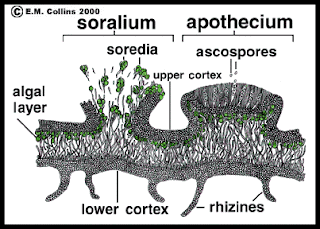It isn’t known as well as it should be that both Georg F
Hegel and Beatrice Potter were players in the study of the biology of the
lichen, which in turn revolutionized the study of natural selection. Or at
least I didn’t know. I do now thanks to Jan Sapp’s Evolution by Association: a
history of symbiosis. A book I’d heartily recommend.
Hegel came first. Technically, Hegel didn’t know a lichen
from a snowy owl. But he did put forward a view of the master-slave relationship
in the Phenomenology of Spirit which must have influenced Simon Schwendener, a
Swiss biologist who looked at lichens through the microscope and was startled
by the fact, as he saw it, that lichens were not plants or organisms like the
oak and the tiger. Rather, he claimed, they were composites.
“Lichens, he argued,
represented a master-slave relationship. The master was a fungus of the order scomycetes,
"a parasite which is accustomed to live upon the work of others; its
slaves are green algals, which it has sought out or indeed caught hold of, and
forced into its service." He went on to describe how the fungus surrounds
the alga, "as a spider does its prey, with a fibrous net of narrow meshes,
which is gradually converted into an impenetrable covering. While, however, the
spider sucks its prey and leaves it lying dead, the fungus incites the algae
taken in its web to more rapid activity, nay, to more vigorous increase."7
This view, which Schwendener released to the world in 1868
(when, in America, they were putting in place the 13th and 14th
amendments), was immediately controversial. Some thought this messed up the
whole Linnean schema, and thus it couldn’t be true – another instance of
classification influencing the classified. But Beatrice Potter in the 1890s
also looked at lichens, and saw that Schwendener was right, at least about
lichens being composite. But the paper she wrote about it had to be given to
the Linnean society by her uncle, since the society didn’t allow women – even in
the audience. And she couldn’t proceed with her studies as the British Museum
because she was a woman who had made a stink. So she said to hell with it and
turned to writing classic children’s tales. I don’t know if any enterprising
critic has seen a lichenous theme in the Tale of Peter Rabbit, but I’d bet
there is one somewhere.
Of course, in the 1860s and in the 1890s, the real
intellectuals thought everything was competition. Surely! Superior races
succeeding inferior ones, and all that. Nature bloody in tooth and claw. So the
idea that all might actually be something else – cooperation – that was an
offense to the Zeitgeist. If this was true, anarchy would rule the world!
These political views were not separate from the science.
The positivist view that science floats on a cloud of theory above objective
facts gives us a poor sense of what science does, since in the end theory is
always about interpreting and organizing facts – and showing which ones are
pertinent and which aren’t, showing what explains exceptions, etc. Just as the
political economics of Malthus run through Darwin – which is not a criticism of
Darwin, but an explanation of how science reaches out for models – so to the
beginning of the discovery of symbiosis was couched, plainly, in terms of
political power. Its rejection, too – a rejection
of any model that can’t be reduced to competition – is plainly political. Which
isn’t to say it is wrong; rather, the controversies it arouses depend very much
on organizing our vision of things.
It was out of this kind of controversy that symbiosis, as
distinct from parasitism, was born:
“Some came to see in the lichen the
possibility of a
more general phenomenon: associations between
phylogenetically distinct organism
that ranged from the loosest to the most
intimate and essential, and
from the most antagonistic and one-sided to
the most beneficial for the wellbeing
of both associates. A neutral term was
required that did not prejudge
such relationships as parasitic. Therefore,
in 1877, Albert Bernhard Frank
(1839-1900) at Leipzig coined the word Symbiotismus:
"We must bring all the
cases where two different species live on or
in one another under a comprehensive
concept which does not consider the role
which the two individuals play
but is based on the mere coexistence and for
which the term Symbiosis
{Symbiotismus} is
to be recommended.”
Interestingly, the other term in contention at that time was
“mutualism”. This, naturally, was abhorrently sentimental to biologists who
unthinkingly adopted the term “competition”, as if this was not rooted in a
very heteronormative sentimentality that sits in an EZ chair, waves a pennant
and roots for the home team.




No comments:
Post a Comment